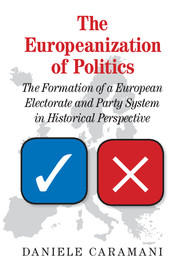 The Europeanization of Politics
The Europeanization of Politics Book contents
- Frontmatter
- Contents
- List of Figures
- List of Tables
- Preface and Acknowledgements
- List of Abbreviations
- Introduction: Electoral Integration in Europe
- Part I Framework
- Part II Analysis
- Part III Assessment
- Conclusion: Towards Europe-wide Representation
- Appendices
- Appendix 1 Party Families
- Appendix 2 Scales
- Appendix 3 Computations
- Appendix 4 R Output for Chapter 5 (QCA)
- Appendix 5 Cases with More than One Cabinet in the Same Year
- Appendix 6 Sources
- References
- Index
Appendix 1 - Party Families
from Appendices
Published online by Cambridge University Press: 05 November 2015
- Frontmatter
- Contents
- List of Figures
- List of Tables
- Preface and Acknowledgements
- List of Abbreviations
- Introduction: Electoral Integration in Europe
- Part I Framework
- Part II Analysis
- Part III Assessment
- Conclusion: Towards Europe-wide Representation
- Appendices
- Appendix 1 Party Families
- Appendix 2 Scales
- Appendix 3 Computations
- Appendix 4 R Output for Chapter 5 (QCA)
- Appendix 5 Cases with More than One Cabinet in the Same Year
- Appendix 6 Sources
- References
- Index
Summary
In many cases names of parties change over time. Because a detailed description is not a priority of this book, shortcuts and simplified names are used. Table A.1.1 indicates which parties are included in each family. For the general criteria for the attribution of codes, see Chapter 2.
For four small families no table has been produced:
Animalist parties: there is only one such party, namely the PvdD in the Netherlands between 2006 and 2010.
Pro-alcohol parties: there are only two instances: the SPP-Beer in 1992–6 in the Czech Republic and the PPPP in 1991–3 in Poland.
Feminist parties: three such parties existed in Iceland (WA in 1983–99), Latvia (SS in 1931), and Lithuania (LMP-Women's Party in 1996–2000), in addition to the Slovenian GZS and the Swedish Feminist Initiative (both in EP elections only).
Pro-European parties in national elections: the EK in Cyprus has been considered (1981–2001), as well as three Czech parties (SNK in 2002–10, DU in 1996–2002 and US 1998–2002). Most pro-European parties run in EP elections (see Table A.1.2).
In Table A.1.1 dates refer to election years with the indication of the first and last elections contested by each party and in which the party received at least 1 per cent of votes nationwide. Periods between the first and last elections during which a party did not exist or did not reach the 1 per cent threshold for inclusion in the analysis are not reported. Party families are listed alphabetically. Czech Republic as Czechoslovakia from World War I until separation. As far as European elections are concerned, parties that participate exclusively in elections to the EP (i.e. do not appear in figures for national elections) are listed in Table A.1.2.
- Type
- Chapter
- Information
- The Europeanization of PoliticsThe Formation of a European Electorate and Party System in Historical Perspective, pp. 297 - 310Publisher: Cambridge University PressPrint publication year: 2015
